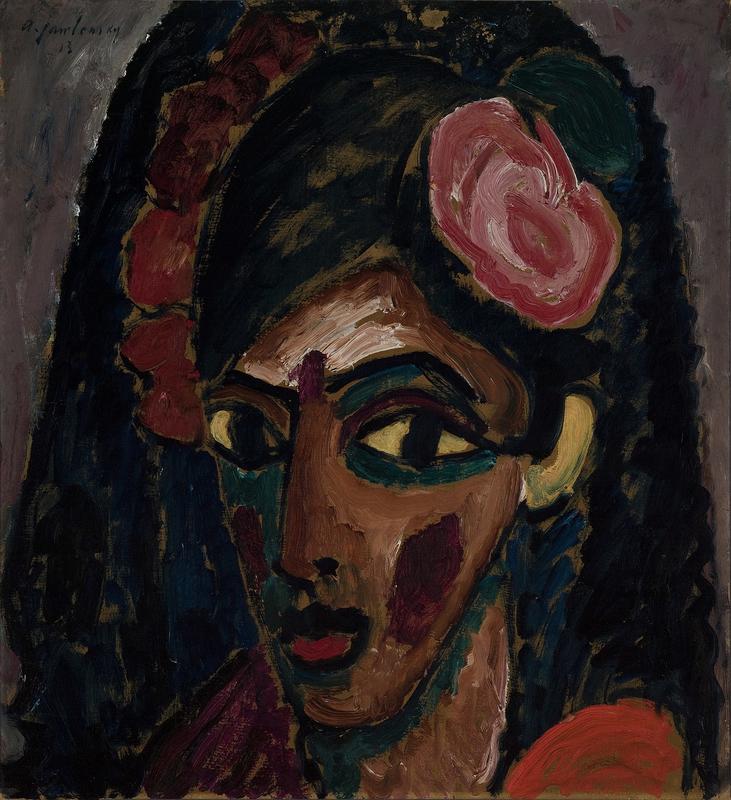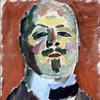More about Egyptian Girl

Contributor
Jawlensky's Egyptian Girl is a product of the artist's new ideas after leaving the group he had helped to start, the Neue Künstlervereinigung München, "New Munich Artists' Group," or NKvM.
Sometimes, in revolutionary movements, there is a surplus of revolutionaries and not enough faithful followers. By the year prior tothe creation of Egyptian Girl, with the specter of World War I looming on the horizon, a splinter group of the NKvM had coalesced, attacking Wassily Kandinsky, a central member of the NKvM, in a publication entitled "Das Neue Bild." Otto Fischer wrote that "a picture without a subject," a thinly-veiled jab at Kandinsky's abstractions, "is meaningless. Half subject and half soul is pure delusion." Certainly Egyptian Girl contains a subject, but Jawlensky was no longer a member of the group, which disbanded in protest against Fischer's attack on Kandinsky and abstraction.
Egyptian Girl was born into the milieu of the 'Blaue Reiter', the Blue Rider group, which had existed for two years in Munich. It included Kandinsky, Franz Marc, Gabriele Münter, Paul Klee, and August Macke. The group sought to bring out the unconscious energies in each artist by a somewhat automatic process of composition, rather than requiring everyone to march to the same intellectual drumbeat. For its first show, two years before Egyptian Girl, Kandinsky wrote, "We do not seek to propagate a precise or special form, but aim to show in the diversity of the forms represented how the inner desire of artists shapes itself in manifold ways."
The Egyptian Girl is an expression of a "synthesis," a word Jawlensky enjoyed using at the time. On the one pole of the synthetic crossroads were his inner feelings, which were both the sacred epicenter of the Blaue Reiter program and the foundation of Freudian psychoanalysis, which was blowing up across Europe like a vinegar and baking soda smoothie. On the other pole were ideal, non-representational, apparently timeless symbols, which Marc wrote, "belong on the altars of the coming intellectual religion, behind which the technical producer vanishes." It seems like the technical producer has not yet vanished, and I don't see where exactly we can make the surgical incision to separate technique, intellect, and religion, but it's a totally far-out idea, to be sure.
The German Blue Riders didn't make it through the war, and the Russian members fled, but Jawlensky would keep the spirit of the group going a few years later with yet another group, the Blue Four.
Sources
- Dube, Wolf-Dieter. The Expressionists. New York: Thames & Hudson, 1985.
- Edwards, Steve, and Paul Wood. Art of the Avant-Gardes. New Haven: Yale University Press, 2004.
- Elger, Dietmar. Expressionism: A Revolution in German Art. Köln: Taschen, 2002.
- Harrison, Thomas. 1910: The Emancipation of Dissonance. Berkeley: University of California Press, 1996.
- Kentgens-Craig, Margret. The Bauhaus and America: First Contacts, 1919-1936. Cambridge: MIT Press, 2001.
- Tesch, Jürgen, and Eckhard Hollmann. Icons of art: the 20th century. Munich: Prestel, 1997.
- Zweite, Armin, and Peter Jelavich. Kandinsky und München: Begegnungen und Wandlungen 1896 - 1914. Munich: Prestel, 1982.











